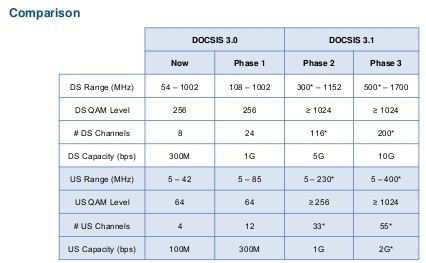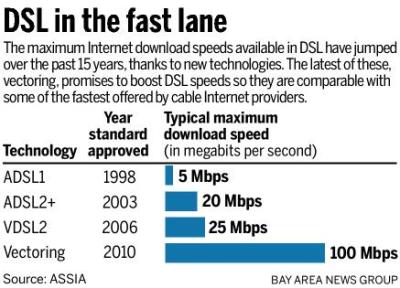
Next year’s upgrade to DOCSIS 3.1 will support cable broadband speeds up to one gigabit shortly after introduction.
Telephone companies relying on traditional ADSL service to power their broadband offering will likely face a renewed competitive assault in 2016 that will further reduce their already-challenged market share in areas where cable companies compete.
Cable operators are hungry for profitable broadband customers and the best place to find new prospects is at the phone company, where DSL is still a common technology to deliver Internet access. But while cable Internet speeds have risen, significant DSL speed hikes have proven more modest in the residential market.
In 2016, the cable industry intends to poach some of the remaining price-sensitive holdouts still clinging to DSL with revised broadband offers promising more speed for the dollar.
Cable broadband has already proven itself a runaway success when matched against telephone company DSL service. Over the last year, Strategy Analytics found Comcast and Time Warner Cable alone signed up a combined 71 percent of the three million new broadband customers in the U.S.
“Cable operators continue to increase market share in U.S. broadband,” said Jason Blackwell, a director at Strategy Analytics. “Over the past twelve months, Comcast has accounted for 42 percent of new subscribers among the operators that we track. Fiber growth is still strong, but the telco operators haven’t been able to shake off the losses of DSL subscribers. In 2016, we expect to see a real battle in broadband, as cable operators begin to roll out DOCSIS 3.1 for even higher speed offers, placing additional pressure on telcos.”
That battle will come in the form of upgraded economy broadband plans, many arriving shortly after providers upgrade to the DOCSIS 3.1 cable broadband platform. Currently those plans offer speeds ranging from 2-6Mbps. Starting next year, customers can expect economy plan prices to stay generally comparable to DSL, with promises of faster and more consistent speeds. A source tells Stop the Cap! at least two significant cable operators are considering 10Mbps to be an appropriate entry-level broadband speed for 2016, in keeping with FCC chairman Thomas Wheeler’s dislike of Internet speeds below 10Mbps.
 Just a few years earlier, most providers wouldn’t think of offering discounted 10Mbps service, fearing it would cannibalize revenue as customers downgraded to get lower priced service. Increasing demands on bandwidth from online video and multiple in-home users have gradually raised consumer expectations, and their need for speed.
Just a few years earlier, most providers wouldn’t think of offering discounted 10Mbps service, fearing it would cannibalize revenue as customers downgraded to get lower priced service. Increasing demands on bandwidth from online video and multiple in-home users have gradually raised consumer expectations, and their need for speed.
Unfortunately for many phone companies that have neglected significant investment in their aging wireline networks, the costs to keep up with cable will become unmanageable unless investors are willing to tolerate significant growth in capital expenses to pay for network upgrades. Frontier Communications still claims most of their customers are satisfied with 6Mbps DSL, neglecting to mention many of those customers live in areas where cable competition (or faster service from Frontier) is not available.
Where competition does exist, it’s especially bad news for phone companies that still rely on DSL. Earlier this year, Frontier’s former CEO Maggie Wilderotter admitted Frontier’s share of the residential broadband market had dropped to less than 25% in 26 of the 27 states where it provides service. In Connecticut, the one state where Frontier was doing better, its acquired AT&T U-verse system has enabled the phone company to deliver broadband speeds up to 100Mbps. But even those speeds do not satisfy state officials who are seeking proposals from providers to build a gigabit fiber network in a public-private partnership.

DSL speed upgrades have been spotty and more modest.
Frontier’s recent experiments with fiber to the home service in a small part of Durham, N.C., and the unintentional revelation of a gigabit broadband inquiry page on Frontier’s website suggests the company may be exploring at least a limited rollout of gigabit fiber service in the state. But company officials have also repeatedly stressed in quarterly results conference calls there were no significant plans to embark on a major spending program to deliver major upgrades across their service areas.
Some phone companies may have little choice except to offer upgrades where cable operators are continuing to rob them of customers. In the northeast, where Frontier has a substantial presence, cable operators including Charter, Comcast and Time Warner Cable are committing to additional speed upgrades. Time Warner Cable’s current standard speed of 15Mbps will rise to 50-60Mbps in 2016, up to ten times faster than Frontier’s most popular “up to” 6Mbps DSL plan.
Most of the broadband customer gains won by Comcast and Time Warner Cable come as a result of DSL disconnects. AT&T said goodbye to 106,000 customers during the third quarter. Verizon managed to pick up 2,000 new subscribers overall, almost all signing up for FiOS fiber to the home service. No cable operator lost broadband market share, reported analyst firm Evercore. Leichtman Research offered additional insight, finding AT&T and Verizon were successful adding 305,000 U-verse and FiOS broadband customers, while losing 432,000 DSL customers during the same quarter.
The message to phone companies couldn’t be clearer: upgrade your networks or else.


 Subscribe
Subscribe
Looks like Dan McCarthy is the one who owned up to that 25% penetration, unless I read the transcript too fast
So Frontier has little choice : upgrade to VDSL and G.Fast or else.
Or it could offer service for even less and try to appeal to retirees.
“The message to phone companies couldn’t be clearer: upgrade your networks or else.”
Or else what? They’ve already made a strategic decision to concentrate investment on mobile wireless. And with the FCC not enforcing universal service obligations under Title II of the Communications Act, there are no regulatory consequences for failing to modernize and build out landline infrastructure.
to Fred : You’re referring to AT&T and Verizon who want OUT of wireline and are selling off those assets. CenturyLink, Fairpoint, Frontier and Windstream are the landline companies and they are getting the message to upgrade. That’s why they are taking CAF II funding.
The deathstar took CAF II funding as well. The only difference is that they openly committed fraud and with these merger contracts they committed perjury as well. Where is the so called consumer advocates FTC/FCC/DOJ or have they been bought out by the oligopolies?
According to the 11/2/15 blog post excerpted below, the lower tier telcos (in this case Frontier) are accepting CAF funding but not for upgraded (fiber) infrastructure, but rather legacy copper-based DSL that will be obsolete before it’s even deployed. So it can’t really be called a future-facing infrastructure upgrade. (Begin post) Meanwhile, Frontier has taken a huge amount of money recently from the Connect America Fund for the purpose of raising rural DSL up to the 10/1 Mbps level. But they have six years to get to those speeds, and most of us in the industry think that even after… Read more »
Stop capping it or else.
I don’t like that “fast lane” graphic because one of the biggest problems is that we get saturation media coverage about G.Fast that makes it sound like it will make a difference, but really it is only good if you live a few blocks from the CO. The trouble with that is in the real world, places that are a few blocks from the CO usually have cable, so if the telcos make the miniscule investment that it takes to upgrade DSL for adjacent customers (a nice VDSL2 line card costs about as much as a month of services) at… Read more »
Agreed that FTR’s biggest problem is its slow DSL speeds offered for the vast majority of their customers. FTR seems to be banking EVERYTHING on Uncle Sam’s $$$ to upgrade FTR’s broadband, but competitors are beating them to the punch. IMHO, Uncle Sam is not the most dependable financier. Misconception by many observers is that FTR doesn’t have to worry about competition from Cablecos or others. Virtually every Central Illinois small town has cable TV service, usually Comcast or Mediacom. Only people that live far from town would NOT have a cable offering. In most cases, the small towns have… Read more »